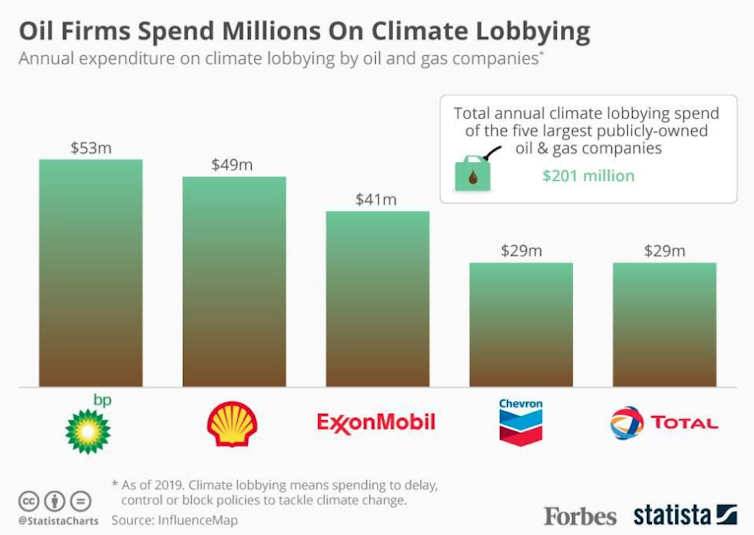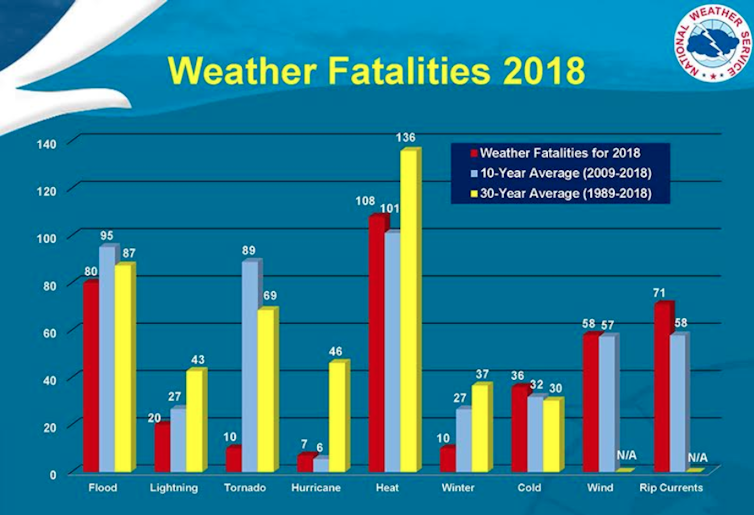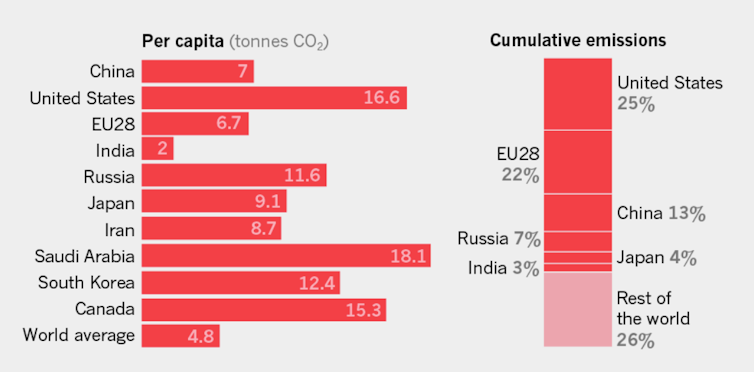
It’s possible that I shall make an ass of myself. But in that case one can always get out of it with a little dialectic. I have, of course, so worded my proposition as to be right either way (K.Marx, Letter to F.Engels on the Indian Mutiny)
Saturday, January 18, 2020

Dancing, singing and disrobing: France's unusual pension reform protests
Issued on: 17/01/2020

Issued on: 17/01/2020

Striking ballerinas perform a free public show in Paris on
December 24, 2019. © FRANCE 24
Text by:FRANCE 24Video by:Sam BALL
From dancing ballerinas to disrobing lawyers, French workers protesting the current pension reforms and other grievances have been finding innovative and eye-catching ways to show their discontent.
France has been hit by strikes and protests for the past six weeks, driven by anger over government plans to streamline the country’s complex pension system. But numbers at demonstrations have been dwindling in recent days amid signs the movement is running out of steam.
Some, however, have turned to alternative forms of protest to express their discontent at the reforms and other grievances in often eye-catching and innovative ways.
The trend began on December 24 last year when striking ballet dancers performed a free show on the steps of the famed Palais Garnier opera house in Paris. A week later, members of the Paris Opera orchestra followed suit with their own public performance.
Others have been using the tools of their trades to get their point across, including lawyers symbolically ditching their robes at the feet of the country’s justice minister, doctors discarding their white coats and teachers jettisoning their textbooks.
Further innovative forms of protest have seen firefighters turn their hoses on government buildings, flashmob dance routines spring up and striking forensics police staging grisly crime scenes.
Text by:FRANCE 24Video by:Sam BALL
From dancing ballerinas to disrobing lawyers, French workers protesting the current pension reforms and other grievances have been finding innovative and eye-catching ways to show their discontent.
France has been hit by strikes and protests for the past six weeks, driven by anger over government plans to streamline the country’s complex pension system. But numbers at demonstrations have been dwindling in recent days amid signs the movement is running out of steam.
Some, however, have turned to alternative forms of protest to express their discontent at the reforms and other grievances in often eye-catching and innovative ways.
The trend began on December 24 last year when striking ballet dancers performed a free show on the steps of the famed Palais Garnier opera house in Paris. A week later, members of the Paris Opera orchestra followed suit with their own public performance.
Others have been using the tools of their trades to get their point across, including lawyers symbolically ditching their robes at the feet of the country’s justice minister, doctors discarding their white coats and teachers jettisoning their textbooks.
Further innovative forms of protest have seen firefighters turn their hoses on government buildings, flashmob dance routines spring up and striking forensics police staging grisly crime scenes.
Dozens of protesters tried to enter a Paris theatre on Friday where French President Emmanuel Macron was spending the evening with his wife Brigitte.
Around thirty opponents of Macron’s pension reform gathered in front of Paris’s Bouffes du Nord theatre early Friday evening, according to the presidential couple's entourage. After trying to enter the theatre, the demonstrators were moved back by police.
The head of state, who was attending a performance at the time, was "secured" for a few minutes before being able to return to see the play until the end.
The Paris Police headquarters confirmed that the demonstrators had not managed to enter.
The Macrons were attending a performance of "La Mouche" when the activist journalist Taha Bouhafs, sitting three rows behind, tweeted photos that prompted activists to come and disrupt the show, according to a relative of the president.
Protesters storm the theatre #BouffesDuNord after #Macron was reported to be inside by Journaliste #TahaBouhafs, last night#greve18janvier#GiletsJaunes pic.twitter.com/2pZLLqsUAP
— Ian56 (@Ian56789) January 18, 2020
"We were at Paris 7 University for a people's university, someone got a message that Macron was there, so we came to show that we're here, that there's a protest against pension reform, but not only that," said Arthur Knight, one of the protesters.
Bouhafs then asked his tens of thousands of followers whether he should throw his shoes at the president, following the famous gesture of an Iraqi journalist against US President George W. Bush in 2008.
"I'm kidding (...) the security is looking at me weirdly right now," Bouhafs said.
Bouhafs was later arrested and taken into police custody overnight on the grounds he had acted to incite both damage to property and violence.
Je suis actuellement au théâtre des bouffes du Nord (Métro La Chapelle)
3 rangées derrière le président de la république.
Des militants sont quelque part dans le coin et appelle tout le monde à rappliquer.
Quelque chose se prépare... la soirée risque d’être mouvementée. pic.twitter.com/0mfwQPwdzr
— Taha Bouhafs (@T_Bouhafs) January 17, 2020
The president "will continue to go to theatrical performances as usual”, said his entourage. “He will be careful to defend creative freedom so that it is not disrupted by violent political actions.”
The French president has not been seen in public since his appearance in Amiens on 21 and 22 November, before protests against his controversial pension reform kicked off on December 5.
Friday marked the 44th day of a record-breaking transport strike where protesters also targeted the headquarters of the CFDT union, which supports the universal points-based retirement system, and blocked the entrance to the Louvre.
(FRANCE 24 with AFP and REUTERS)
Around thirty opponents of Macron’s pension reform gathered in front of Paris’s Bouffes du Nord theatre early Friday evening, according to the presidential couple's entourage. After trying to enter the theatre, the demonstrators were moved back by police.
The head of state, who was attending a performance at the time, was "secured" for a few minutes before being able to return to see the play until the end.
The Paris Police headquarters confirmed that the demonstrators had not managed to enter.
The Macrons were attending a performance of "La Mouche" when the activist journalist Taha Bouhafs, sitting three rows behind, tweeted photos that prompted activists to come and disrupt the show, according to a relative of the president.
Protesters storm the theatre #BouffesDuNord after #Macron was reported to be inside by Journaliste #TahaBouhafs, last night#greve18janvier#GiletsJaunes pic.twitter.com/2pZLLqsUAP
— Ian56 (@Ian56789) January 18, 2020
"We were at Paris 7 University for a people's university, someone got a message that Macron was there, so we came to show that we're here, that there's a protest against pension reform, but not only that," said Arthur Knight, one of the protesters.
Bouhafs then asked his tens of thousands of followers whether he should throw his shoes at the president, following the famous gesture of an Iraqi journalist against US President George W. Bush in 2008.
"I'm kidding (...) the security is looking at me weirdly right now," Bouhafs said.
Bouhafs was later arrested and taken into police custody overnight on the grounds he had acted to incite both damage to property and violence.
Je suis actuellement au théâtre des bouffes du Nord (Métro La Chapelle)
3 rangées derrière le président de la république.
Des militants sont quelque part dans le coin et appelle tout le monde à rappliquer.
Quelque chose se prépare... la soirée risque d’être mouvementée. pic.twitter.com/0mfwQPwdzr
— Taha Bouhafs (@T_Bouhafs) January 17, 2020
The president "will continue to go to theatrical performances as usual”, said his entourage. “He will be careful to defend creative freedom so that it is not disrupted by violent political actions.”
The French president has not been seen in public since his appearance in Amiens on 21 and 22 November, before protests against his controversial pension reform kicked off on December 5.
Friday marked the 44th day of a record-breaking transport strike where protesters also targeted the headquarters of the CFDT union, which supports the universal points-based retirement system, and blocked the entrance to the Louvre.
(FRANCE 24 with AFP and REUTERS)
Paris Opera musicians serenade public in pension reform protest
Issued on: 18/01/2020
 Musicians perform in front of the Palais Garnier during a demonstration of striking employees of the Opera Garnier and the Comedie Francaise, against the French government's plan to overhaul the country's retirement system in Paris, on January 18, 2020. © Stéphane de Sakutin, AFP
Musicians perform in front of the Palais Garnier during a demonstration of striking employees of the Opera Garnier and the Comedie Francaise, against the French government's plan to overhaul the country's retirement system in Paris, on January 18, 2020. © Stéphane de Sakutin, AFPStriking musicians and singers of the Paris Opera staged an open-air concert on Saturday in front of the city's historic opera house in protest against a pension reform that seeks to end their special retirement scheme.
Orchestra members and singers performed well-known airs by Verdi and Bizet in a half-hour event outside the Opera Garnier building, ending with a rendition of the Marseillaise.
Magique ! #reformesdesretraites #operadeparis #greve pic.twitter.com/Y6hX1Ab7J2— Unsa Ferroviaire Traction CNU (@CnuUnsa) January 18, 2020
The musicians were cheered on by colleagues including ballerinas who last month performed scenes from Swan Lake at the same spot in a similar protest over the proposed pensions overhaul.
The event drew applause from passers-by on a sunny winter's afternoon in the French capital, where performances by the Paris Opera have been cancelled for the past month due to the strike by artists who want to preserve centuries-old retirement provisions.
"We're so unhappy about not being able to give our shows that we're performing in a different way, in the street, to show the public that we're not on holiday," Fabien Wallerand, a tuba player in the Paris Opera's orchestra, told Reuters.
L’Opera de Paris en grève, la Comédie Française en grève. Concert de l’orchestre sur le parvis de l’Opera et défilé des salariés devant les applaudissements du public. « La culture en danger » #Greve18janvier pic.twitter.com/7LedhqVYrZ— Romain Lescurieux (@RLescurieux) January 18, 2020
Protesters clash with police elsewhere in Paris
Elsewhere in Paris, thousands of demonstrators, including “Yellow Vests”, took to the streets shouting slogans against police brutality, President Emmanuel Macron and his pension reforms. They were greeted with tear gas by French police on Saturday, which also arrested several people.
Police said 15 people were arrested after authorities tried to disperse a bloc at the head of the protest in northern Paris, before coming under a hail of projectiles, AFP reporters witnessed.
This was the latest of the weekly demonstrations held every Saturday by the "Yellow Vest" movement since November 2018, which have joined the opposition to the pension reforms.
"We're suffocating with this government who wants to put us on our knees," Annie Moukam, a 58-year-old teacher, said.
"It's out of the question that he (Macron) touches our pensions. We have worked all our lives to be able to leave with a dignified retirement," she said. "It's exactly that that he is challenging."
Saturday’s rallies also came on the 45th day of a strike that has hit train and metro traffic and caused misery for millions of commuters in Paris especially.
Trains are becoming more frequent however, and Paris's metro drivers voted to suspend their action from Monday, their union Unsa announce Saturday.
Under an arrangement dating back to 1698 and the reign of Louis XIV, Paris Opera dancers can retire on a full pension at the age of 42, singers at 57 and musicians at 60.
President Emmanuel Macron's plan to merge France's various pension schemes into a single system has triggered more than a month of strikes, particularly in public transport. However, concessions by the government, notably a delay to a move to raise the age at which workers can claim a full pension from 62 to 64, have contributed to a waning in strikes.
(FRANCE 24 with AFP and REUTERS)
Hundreds of US police departments using 'dystopian' face recognition app — report
A new report in US media has people worried about their privacy as more police forces sign on to use the program. Clearview AI offers facial recognition software that can identify a person even in poor-quality images.
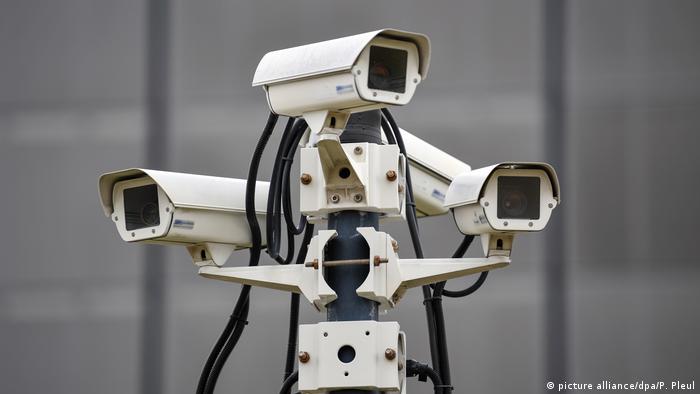
An explosive new US media report published on Saturday revealed that a secretive company has been selling the world's most advanced known facial recognition software to local law enforcement agencies for at least 2 years. Clearview AI searches through public images on social media and can identify an individual even if their face is obscured or not entirely visible.
According to The New York Times, although Clearview has been selling its technology to police forces since 2017, it only really came to public attention at the end of 2019 when its name came up in court documents in a Florida robbery case.
Company knows who police search for
What would become Clearview began in 2016, when Australian entrepreneur Hoan Ton-That met Richard Schwartz, a former aide to President Donald Trump's personal lawyer, Rudy Giuliani, when the latter was mayor of New York. The pair hired engineers and went to work on their app, but it was only when they hit upon the idea to sell the technology to US police forces that they attracted the attention of major investors.
One of these investors was Peter Thiel, the co-founder of PayPal who famously funded a lawsuit that bankrupted the media blog Gawker, which had run a story about Thiel that he allegedly did not like.
The Times reported that the first attempts to reach out to Clearview were murky, as the company's website listed an address in New York City that did not exist. Furthermore, shortly after a reporter asked someone in law enforcement to run their picture, the officer was contacted by Clearview and questioned about whether they were speaking to the media. This likely means that the company is keeping tabs as police watch suspects.
When Ton-That finally spoke to the media, he acknowledged that there was code in his program that would allow police to wear augmented-reality glasses and be able to tell the name, job and acquaintances of anyone they saw on the street. However, he denied plans to actually sell this technology to anyone.
'Facebook knows'
Pressed to answer whether he was violating Facebook's terms of service by taking their images without consent, Ton-That replied: "A lot of people are doing it. Facebook knows."
The company claims that its software has been used to solve child sexual abuse cases, identify a John Doe and solve identity-fraud cases at banks, though there did not appear to be any proof of this.
The app reportedly has about 75% accuracy.
These revelations immediately sparked fears about what the software means for privacy, with many social media users calling the news "scary" and "dystopian."
In authoritarian China, high-level facial recognition software is already in widespread government use. Since December, a new law requires everyone who buys a SIM card to submit facial recognition scans that are registered with their phone. Throughout China, these kinds of apps are already in use in schools, on public transportation and in places like concert venues.
In the US, less advanced types of facial recognition have been in use for decades. Recently, Britain, France and Russia have all embraced it as well, though they do not yet have access to programs as high-tech as Clearview's.
Germany, famously critical of surveillance and having one of the lowest numbers of CCTV cameras in the developed world, still has no legal framework for such technology, although pilot projects have been tested on very small scales.
DW RECOMMENDS
China launches compulsory face scans for new phone users
Telecom operators must now collect face scans when registering users of new phones at stores across China. Last month, one of the country's first lawsuits was filed over facial recognition amid growing privacy concerns. (01.12.2019)
India setting up world's biggest facial recognition system
The Indian government is preparing to install a nationwide facial recognition system, but the plan draws criticism from rights activists and tech experts who warn of the risks to privacy and from increased surveillance. (07.11.2019)
In Germany, controversy still surrounds video surveillance
Surveillance cameras at train stations and in public places have long become a well-established part of everyday life. Facial recognition software, however, is not. In Germany, that could soon change. (24.10.2019)
France embraces facial recognition tech
Civil rights groups worry France is taking a step toward a surveillance state. It is about to become the first European Union country to introduce facial recognition software for government services. (10.11.2019)
AUDIOS AND VIDEOS ON THE TOPIC
British Police use Facial Recognition
A new report in US media has people worried about their privacy as more police forces sign on to use the program. Clearview AI offers facial recognition software that can identify a person even in poor-quality images.

An explosive new US media report published on Saturday revealed that a secretive company has been selling the world's most advanced known facial recognition software to local law enforcement agencies for at least 2 years. Clearview AI searches through public images on social media and can identify an individual even if their face is obscured or not entirely visible.
According to The New York Times, although Clearview has been selling its technology to police forces since 2017, it only really came to public attention at the end of 2019 when its name came up in court documents in a Florida robbery case.
Company knows who police search for
What would become Clearview began in 2016, when Australian entrepreneur Hoan Ton-That met Richard Schwartz, a former aide to President Donald Trump's personal lawyer, Rudy Giuliani, when the latter was mayor of New York. The pair hired engineers and went to work on their app, but it was only when they hit upon the idea to sell the technology to US police forces that they attracted the attention of major investors.
One of these investors was Peter Thiel, the co-founder of PayPal who famously funded a lawsuit that bankrupted the media blog Gawker, which had run a story about Thiel that he allegedly did not like.
The Times reported that the first attempts to reach out to Clearview were murky, as the company's website listed an address in New York City that did not exist. Furthermore, shortly after a reporter asked someone in law enforcement to run their picture, the officer was contacted by Clearview and questioned about whether they were speaking to the media. This likely means that the company is keeping tabs as police watch suspects.
When Ton-That finally spoke to the media, he acknowledged that there was code in his program that would allow police to wear augmented-reality glasses and be able to tell the name, job and acquaintances of anyone they saw on the street. However, he denied plans to actually sell this technology to anyone.
'Facebook knows'
Pressed to answer whether he was violating Facebook's terms of service by taking their images without consent, Ton-That replied: "A lot of people are doing it. Facebook knows."
The company claims that its software has been used to solve child sexual abuse cases, identify a John Doe and solve identity-fraud cases at banks, though there did not appear to be any proof of this.
The app reportedly has about 75% accuracy.
These revelations immediately sparked fears about what the software means for privacy, with many social media users calling the news "scary" and "dystopian."
In authoritarian China, high-level facial recognition software is already in widespread government use. Since December, a new law requires everyone who buys a SIM card to submit facial recognition scans that are registered with their phone. Throughout China, these kinds of apps are already in use in schools, on public transportation and in places like concert venues.
In the US, less advanced types of facial recognition have been in use for decades. Recently, Britain, France and Russia have all embraced it as well, though they do not yet have access to programs as high-tech as Clearview's.
Germany, famously critical of surveillance and having one of the lowest numbers of CCTV cameras in the developed world, still has no legal framework for such technology, although pilot projects have been tested on very small scales.
DW RECOMMENDS
China launches compulsory face scans for new phone users
Telecom operators must now collect face scans when registering users of new phones at stores across China. Last month, one of the country's first lawsuits was filed over facial recognition amid growing privacy concerns. (01.12.2019)
India setting up world's biggest facial recognition system
The Indian government is preparing to install a nationwide facial recognition system, but the plan draws criticism from rights activists and tech experts who warn of the risks to privacy and from increased surveillance. (07.11.2019)
In Germany, controversy still surrounds video surveillance
Surveillance cameras at train stations and in public places have long become a well-established part of everyday life. Facial recognition software, however, is not. In Germany, that could soon change. (24.10.2019)
France embraces facial recognition tech
Civil rights groups worry France is taking a step toward a surveillance state. It is about to become the first European Union country to introduce facial recognition software for government services. (10.11.2019)
AUDIOS AND VIDEOS ON THE TOPIC
British Police use Facial Recognition
Women's March: Thousands protest against Donald Trump
Thousands of women have slammed the US president's assault on reproductive rights, climate change and immigration. One protester called Trump the "biggest bully in the world."
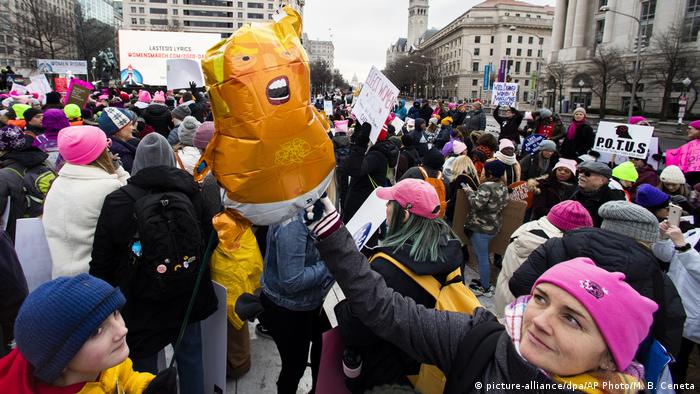
Thousands of women gathered for an annual march in Washington and more than 180 other cities to protest US President Donald Trump's targeting of women's rights.
"I am even more outraged than I was three years ago," said a placard carried by a 40-year-old Washington resident. "We all knew that Trump was going to be horrible, and he has been even more horrible than we realize."
Despite the drop in numbers, with only a few thousand participants on the streets of Washington, activists remained hopeful about the power to organize.
"It is a cold day and it does not matter if its 10 people or 100 people or 1,000 people if our voices are strong," said a 50-year-old woman who said she regularly attends the march that started in 2017. "We are powerful together — that's the most important thing."
The 2017 Women's March drew nearly 1 million people to the streets of Washington, DC, and hundreds of thousands in other US cities one day after Trump's inauguration.
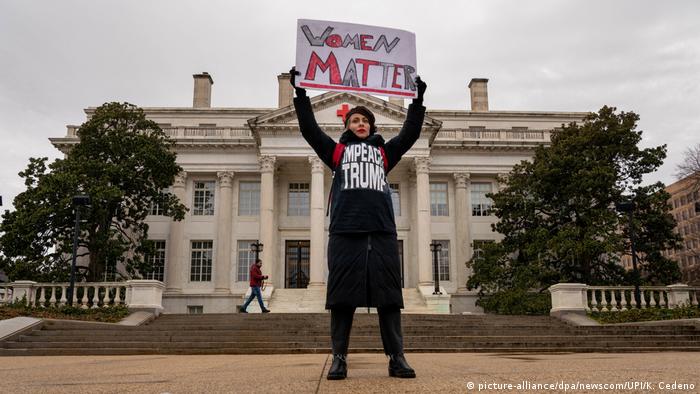
Hot on the heels of the beginning to Trump's impeachment in the Senate, protesters made jabs at the US president
Assault on women's rights
Many of the protesters cited Trump's hard-line policy on women's reproductive rights, climate change and refugees as major motivators for joining the march.
"Look what's he's doing to Greta Thunberg," said a 70-year-old climate activist, referring to the teenage Swedish activist who launched the Fridays for Future school strikes to draw attention to the man-made destabilization of earth's climate. She was named Time magazine's Person of the Year in 2019.
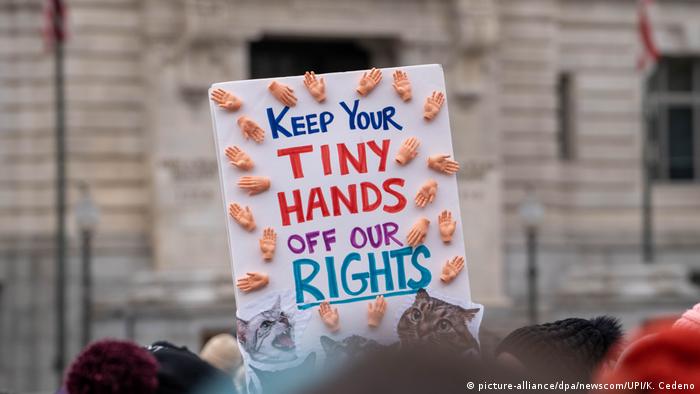
Protesters were critical of the Trump administration's attempts to restrict women's reproductive rights
'Biggest bully'
Trump has regularly targeted Thunberg on Twitter and lamented climate change as a ploy "created by and for the Chinese in order to make US manufacturing non-competitive."
"He's the biggest bully in the world," added the 70-year-old activist.
Other protests took place in New York, Los Angeles and other major cities across the US.
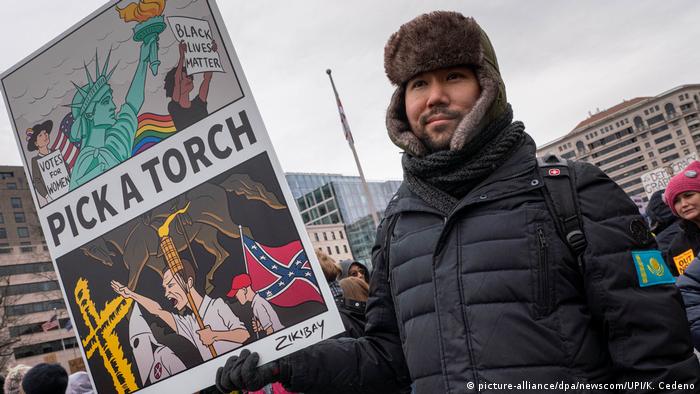
Some men joined the march in solidarity
Local criticism
But not everyone was thrilled with the Women's March in Washington. DC-based activists criticized organizers for going forward with the march, saying they undermined efforts to highlight local issues.
"Local DC is a domestic colony and the actions of national organizers have to recognize that," said Black Lives Matter DC in a letter for the Women's March organizers.
"Here in DC, these unstrategic mass mobilizations distract from local organizing, often overlook the black people who actually live here and even result in tougher laws against demonstration being passed locally."
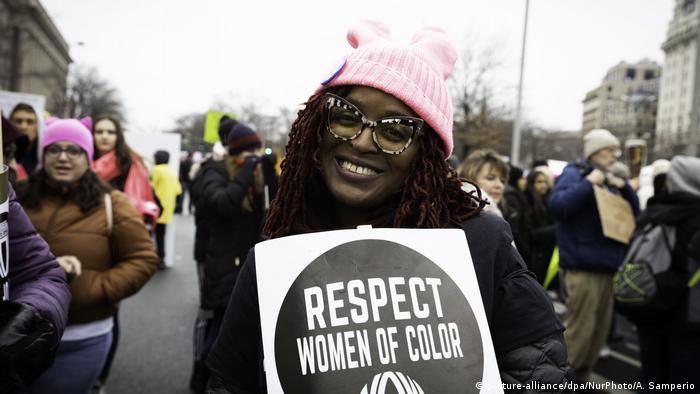
Protesters drew attention to marginalized communities, including people of color and the LGBT+ community
National Archive: 'We apologize'
The march was held the same day the US National Archives apologized for blurring anti-Trump signs in a promotional image for a women's suffrage exhibition.
"We made a mistake," said the National Archives. "As the National Archives of the United States, we are and have always been completely committed to preserving our archival holdings, without alteration."
"We have removed the current display and will replace it as soon as possible with one that uses the unaltered image," it added. "We apologize."
Read more: Opinion: Trump earned his impeachment
GERMANY
Explainer: What are Germany's farmers so angry about?
Thousands of farmers have taken to the streets in cities across Germany to protest new environmental regulations. They're demanding more dialogue to address the increasing challenges facing the agriculture sector.
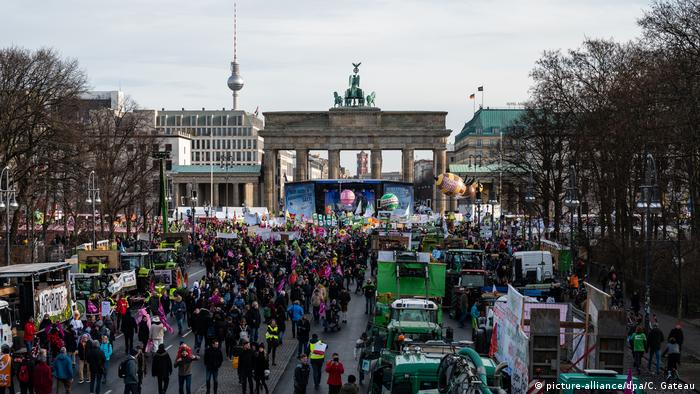
GERMAN FARMERS AND ACTIVISTS PROTEST DURING GREEN WEEK IN BERLIN
German environmentalists are 'fed up'
Around 27,000 people protested Saturday in Berlin for environmentally friendly agriculture policy, according to organizers. The protests, planned by the coalition "wir haben es satt!" (we're fed up), coincide with International Green Week, a major agriculture and food fair that started on Friday.
123456
Farmers brought out hundreds of tractors to block the streets of Berlin and several other cities in northern Germany this weekend, the culmination of months of protests to coincide with the start of International Green Week — a major agriculture and food fair in the German capital.
But what do the farmers want, and what can the government do?
Who is organizing the protest?
This weekend's demonstrations are different from previous farmers' demos, as they have been organized by a grassroots movement rather than the official agricultural industry association. Land schafft Verbindung (LsV) ("Country Creates Connection"), as the movement is called, was born of a Facebook group last October and now claims a social media network of 100,000 farmers and agricultural workers. It has organization teams in at least seven of Germany's 16 states.
Read more: German farmers: 'Over-regulation is the last thing we need'
Farmers sue German government over climate change
What's the problem?
German farmers are at the mercy of supermarkets and the food industry in general because they have little recourse when retailers drive down prices to compete with each other. This has had real social consequences: LsV calculates that the average agricultural worker in Germany earns just €22,000 ($24,000), and that more than half of German farmers have shut down their businesses in the last few years.
This economic pressure, according to LsV, has been exacerbated by new government regulations restricting the use of fertilizer, manure and insecticides. Germany has seen a catastrophic crash in insect populations in recent years, while nitrate levels in the water table are a growing concern. The LsV says measures, hashed out by Agriculture Minister Julia Klöckner and Environment Minister Svenja Schulze last year, were agreed without consulting farmers, and they will drive even more farms out of business.
What are the farmers demanding?
The LsV says the restrictive measures will drive up costs, which means supermarkets will look to cheap imports. They say this will end up damaging the environment: food imports are responsible for more carbon emissions through extra transport, and there is no way to influence ecological or social standards in the countries of origin. "And so our regional food production, which is constantly being demanded in society, will be weakened even further," the LsV says on its website.
The farmers' demands include:
A new scientific study into the insect depopulation, which will look beyond agriculture at other possible causes like telecommunications infrastructure, LED lighting and changing weather patterns
An "objective investigation" of the nitrate measuring stations, in order to "distinguish between agricultural and non-agricultural causes," and an expansion of the measuring networks, to gain more data
Regulations mandating that imported food meets German standards, or new labels marking food as having been "produced below legal German standards." Farmers have also called for labels identifying regional products
Farming and climate change
What has been the government response?
Agriculture Minister Julia Klöckner has argued that environmental measures — delayed for many years — are necessary to avoid punitive fines from the European Union: up to €800,000 per day in taxpayers' money. At the same time, in an interview published Friday by news portal t-online, Klöckner said she is sympathetic to the LsV's demands for more transparency in nitrate measuring systems.
Klöckner also said German consumers need to be prepared to pay more for food. "There is a difference between cheap food and the offer of agricultural products at absolute dumping prices," she said. "The fact is that within the EU, Germany is at the bottom end when it comes to the proportion of food in consumer costs: it's below 10%. There's a lot more that people can afford. It's about priorities. There's often enough money for the latest smartphone."
What's the view of the opposition parties?
In a debate with LsV spokesperson Dirk Andresen in the Tagesspiegel, the Green party's parliamentary leader Anton Hofreiter pointed out that, contrary to LsV's assertions, insect depopulation and the decline of animal diversity has been proven to be related to industrial-scale farming. Green agricultural policy spokesman Friedrich Ostendorff also said society was simply no longer willing to "accept the high costs for the environment, animals and the climate associated with the industrialized agricultural system."
Kirsten Tackmann of the socialist Left party blamed the crisis on the government's failure to tackle market inequalities. "The market power of large retail companies blackmails all the local agricultural businesses who create their wealth," she told t-online. "Without fair production prices the ecological problems in agricultural problems won't be solvable either. Unfair market rules, adverts with dumping prices for food and land speculation need to be stopped."
Lebanese block roads as revived protests enter fourth month
Issued on: 18/01/2020

Text by:FRANCE 24
Protesters blocked several main roads across Lebanon on Friday as unprecedented demonstrations against a political elite accused of corruption and incompetence entered their fourth month.
The protest movement rocking Lebanon since October 17 has resurged this week, over delays in forming a new cabinet to address the country's growing economic crisis.
No progress seemed to have been made on a final lineup, which protesters demand be made up solely of independent experts and exclude traditional political parties.
In central Beirut, dozens of protesters Friday stood between parked cars blocking a key thoroughfare linking the city's east and west.
"We blocked the road with cars because it's something they can't move," Marwan Karam said.
The protester condemned what he regarded as efforts to form yet another government in which power is divided among the traditional parties.
"We don't want a government of masked political figures," the 30-year-old told AFP. "Any such government will fall. We won't give it any chance in the street."
But fixing the country's spiralling economic crisis is now protesters' most pressing need, explained FRANCE 24's Leila Molana-Allen, reporting from Beirut.
Can't pay for their daily necessities
"People are losing their jobs, they’re losing the hours they work, the currency is also in a sharp downward tilt. Prices have gone up. We’ve seen thirty-five to forty percent inflation in just the last three months. The average price of a shopping basket has gone up that much," said Molana-Allen.
"People can’t pay for their daily necessities. Their rent, their heating, their food. And so although the protesters do want a wholesale change in the government, what they want right now is the election of a new government, they want a cabinet of specialists who can come in and fix this economic crisis. That’s now the urgent need," Molana-Allen added.
Forming a new cabinet is often a drawn-out process in Lebanon, where a complex system seeks to maintain balance between the various political parties and a multitude of religious confessions.
Carlos Yammine, 32, said he did not want yet another "cake-sharing government".
"What we have asked for from the start of the movement is a reduced, transitional, emergency government of independents," he said, leaning against his car.
Demonstrators also blocked roads in second city Tripoli Friday morning, although they were cleared later in the day, local media reported. Protests also took place in the southern port city of Tyre later in the day.
'Unacceptable' violence
On Friday evening, hundreds of protesters gathered near the parliament and outside the central bank, the target of renewed anger amid the worst economic crisis that Lebanon has experienced since its 1975-1990 civil war.
Protests this week saw angry demonstrators attack banks following the imposition of sharp curbs on cash withdrawals to stem a liquidity crisis.
On Thursday night, protesters vandalised three more banks in the capital's Hamra district, smashing windows and defacing ATMs, an AFP photographer said.
Earlier, Lebanon's security services released most of the 100-plus protesters detained over the previous 48 hours, lawyers said.
Human Rights Watch on Friday condemned the arrests and the response of security forces to protests outside a police station on Wednesday night demanding detainees be released.
"The unacceptable level of violence against overwhelmingly peaceful protesters on January 15 calls for a swift independent and transparent investigation," said Joe Stork, deputy Middle East director at the rights watchdog.
Over the past few months, the Lebanese pound -- long pegged to the US dollar at 1,507 -- has fallen in value on the unofficial market to around 2,500.
The World Bank has warned that the poverty rate in Lebanon could rise from a third to a half if the political crisis is not remedied fast.
(FRANCE 24 with AFP)
Lebanon protests: Anti-government protesters clash with police
Anti-government protesters and the security forces have clashed in central Beirut.
More than 160 people have had to be treated for injuries in the latest violence.
Clashes between police and protesters in Lebanon angered by delays in forming a government wounded more than 220 people on both sides Saturday as anti-establishment demonstrations enter a fourth month.
The sound of ambulance sirens rang out across Beirut as the Red Cross reported 80 wounded had been taken to hospital and 140 more were treated on site.
The protest movement rocking Lebanon since October 17 revived this week as a deepening economic crisis increases pressure to form a new government.
No progress appears to have been made towards finalising the cabinet, which protesters demand be comprised of independent experts and exclude all established political parties.
FINAL UPDATE: 18 ambulances, 80 EMTs and 6 dispatchers from the LRC responded to the protests in downtown Beirut. Over 80 victims have been transported to nearby hospitals and over 140 injured were treated at the scene. LRC teams are still on standby and ready to respond. pic.twitter.com/p1OG7WFqwl
— Lebanese Red Cross (@RedCrossLebanon) January 18, 2020
‘We won’t pay the price’
After several hours of clashes, the violence died down as demonstrators dispersed. Several were arrested, local media said.
The violence began after dozens of protesters - some concealing their faces in scarves - threw rocks and large plant pots at police guarding the road leading up to parliament, while chanting "We won't pay the price". Others charged police lines with traffic signs and metal barriers.
Security forces behind the barricades responded with water cannon and tear gas to disperse the crowds.
Lebanon's Interior Minister Raya el-Hassan said it was unacceptable for protesters to attack security forces. "I always asserted the right to protest, but for the protests to turn into a blatant assault on the security forces, on public and private property, is condemned and not acceptable at all," she said in a tweet.
اكتر من مرة تعهدت انو احمي التظاهرات السلمية، وكنت دايمن اكد ع أحقية التظاهر. بس انو تتحول ه التظاهرات لاعتداء سافر على عناصر #قوى_الامن والممتلكات العامة والخاصة، فهو امر مدان وغير مقبول ابدا. @LebISF
— Raya Haffar El Hassan (@rayaelhassan) January 18, 2020
The Internal Security Forces also took to the social media: "A direct and violent confrontation is taking place with anti-riot police at one of the entrances to parliament", they tweeted. "We ask peaceful protesters to keep away from the site of the rioting for their safety."
They published photos of several wounded policemen and a video showing pillars stripped of their tiles, reportedly to be thrown at security forces.
An AFP photographer saw young men uproot parking metres. He also saw around 10 people faint from tear gas inhalation.
'Popular anger is the solution'
A 23-year-old woman named Maya said she was protesting because politicians seemed to be ignoring demands for an overhaul of the old political class.
"I'm here because after more than 90 days in the streets, they're still squabbling over their shares in government... It's as if they didn't see our movement," she told AFP. "Popular anger is the solution," she said.
Forming a cabinet is an often convoluted process in Lebanon, where a complex system seeks to maintain balance between the country's many political parties and religious confessions.
But protesters say they want to scrap the old system, and demand a new government of impartial technocrats to address mounting economic woes, including a severe liquidity crisis.
This week public anger has been directed at banks, with branches in the capital's Hamra district vandalised following widely unpopular limits on withdrawals and transfers.
Dozens were detained for several nights after clashes on Tuesday and Wednesday, before being released.
Human rights groups denounced the arrests and what they described as unacceptable violence against largely peaceful protesters.
The last government stepped down under pressure from the street on October 29, but has remained in a caretaker capacity until a new cabinet is formed.
Political factions that agreed on December 19 to appoint former education minister and Professor Hassan Diab as the new premier are now disagreeing over proposed ministers.
The World Bank has warned that the poverty rate in Lebanon could rise from a third to half of the population if the political crisis is not solved quickly.
(FRANCE 24 with AFP and REUTERS)
Lebanon: Scores injured as riots break out in Beirut
At least 200 people, including protestors and police, were injured as fresh demonstrations turned violent in Beirut. Citizens are protesting political paralysis that has led to a catastrophic economic downturn
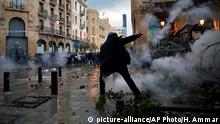
Violent protests in Lebanon flare up again
Some 200 people were wounded in Lebanon's capital of Beirut on Saturday as clashes broke out between security forces and protestors demonstrating outside the parliament building. Many in Lebanon are fed up at what has turned into months without a government, which has had a disastrous effect on the already stagnating economy.
Protestors set fire to ATMs, tried to break the windows of banks, and threw stones at police, who responded with tear gas and water cannons.
The downtown area near the parliament building was covered in thick white smoke as some demonstrators began to remove street signs, metal barriers and branches of trees and toss them at the security services.
"We will not pay the price," chanted some protestors, referencing the national debt, which now stands at $87 billion (€78 billion) or 150% of GDP. This is one of the largest debt ratios in the world.
Read more: The German Bundeswehr's missions in the Middle East
Protesters forced to Martyrs' Square
As more protestors began to gather downtown, police forced them back to the central Martyrs' Square, which has been the hub for a string of recent demonstrations.
President Michel Aoun called on police to protect peaceful protestors and work on restoring as the situation continued into the late evening.
Lebanon has been ruled by the same group of political elites since the end of its 15-year long civil war in 1990. The recent political and economic uncertainty began when Prime Minister Saad Hariri, the son of a former prime minister, announced his resignation in October. Since then, the country's leaders have been dragging their feet on forming a new government.
In recent weeks, panic has begun to set in as the value of the Lebanese pound has plummeted and the influx of foreign goods has ground to a halt in a country that relies mostly on imports for basic necessities. Banks have also imposed strict controls on foreign transfers and the withdrawal of US dollars.
es/mm (AP, AFP)
Issued on: 18/01/2020

Lebanese demonstrators block the main bridge linking the
western and eastern sides of the capital Beirut, to protest
against a political elite accused of corruption and incompetence,
on Janury 17, 2020. © Patrick Baz, AFP
Text by:FRANCE 24
Protesters blocked several main roads across Lebanon on Friday as unprecedented demonstrations against a political elite accused of corruption and incompetence entered their fourth month.
The protest movement rocking Lebanon since October 17 has resurged this week, over delays in forming a new cabinet to address the country's growing economic crisis.
No progress seemed to have been made on a final lineup, which protesters demand be made up solely of independent experts and exclude traditional political parties.
In central Beirut, dozens of protesters Friday stood between parked cars blocking a key thoroughfare linking the city's east and west.
"We blocked the road with cars because it's something they can't move," Marwan Karam said.
The protester condemned what he regarded as efforts to form yet another government in which power is divided among the traditional parties.
"We don't want a government of masked political figures," the 30-year-old told AFP. "Any such government will fall. We won't give it any chance in the street."
But fixing the country's spiralling economic crisis is now protesters' most pressing need, explained FRANCE 24's Leila Molana-Allen, reporting from Beirut.
Can't pay for their daily necessities
"People are losing their jobs, they’re losing the hours they work, the currency is also in a sharp downward tilt. Prices have gone up. We’ve seen thirty-five to forty percent inflation in just the last three months. The average price of a shopping basket has gone up that much," said Molana-Allen.
"People can’t pay for their daily necessities. Their rent, their heating, their food. And so although the protesters do want a wholesale change in the government, what they want right now is the election of a new government, they want a cabinet of specialists who can come in and fix this economic crisis. That’s now the urgent need," Molana-Allen added.
Forming a new cabinet is often a drawn-out process in Lebanon, where a complex system seeks to maintain balance between the various political parties and a multitude of religious confessions.
Carlos Yammine, 32, said he did not want yet another "cake-sharing government".
"What we have asked for from the start of the movement is a reduced, transitional, emergency government of independents," he said, leaning against his car.
Demonstrators also blocked roads in second city Tripoli Friday morning, although they were cleared later in the day, local media reported. Protests also took place in the southern port city of Tyre later in the day.
'Unacceptable' violence
On Friday evening, hundreds of protesters gathered near the parliament and outside the central bank, the target of renewed anger amid the worst economic crisis that Lebanon has experienced since its 1975-1990 civil war.
Protests this week saw angry demonstrators attack banks following the imposition of sharp curbs on cash withdrawals to stem a liquidity crisis.
On Thursday night, protesters vandalised three more banks in the capital's Hamra district, smashing windows and defacing ATMs, an AFP photographer said.
Earlier, Lebanon's security services released most of the 100-plus protesters detained over the previous 48 hours, lawyers said.
Human Rights Watch on Friday condemned the arrests and the response of security forces to protests outside a police station on Wednesday night demanding detainees be released.
"The unacceptable level of violence against overwhelmingly peaceful protesters on January 15 calls for a swift independent and transparent investigation," said Joe Stork, deputy Middle East director at the rights watchdog.
Over the past few months, the Lebanese pound -- long pegged to the US dollar at 1,507 -- has fallen in value on the unofficial market to around 2,500.
The World Bank has warned that the poverty rate in Lebanon could rise from a third to a half if the political crisis is not remedied fast.
(FRANCE 24 with AFP)
Lebanon protests: Anti-government protesters clash with police
Anti-government protesters and the security forces have clashed in central Beirut.
More than 160 people have had to be treated for injuries in the latest violence.
Clashes between police and protesters in Lebanon angered by delays in forming a government wounded more than 220 people on both sides Saturday as anti-establishment demonstrations enter a fourth month.
The sound of ambulance sirens rang out across Beirut as the Red Cross reported 80 wounded had been taken to hospital and 140 more were treated on site.
The protest movement rocking Lebanon since October 17 revived this week as a deepening economic crisis increases pressure to form a new government.
No progress appears to have been made towards finalising the cabinet, which protesters demand be comprised of independent experts and exclude all established political parties.
FINAL UPDATE: 18 ambulances, 80 EMTs and 6 dispatchers from the LRC responded to the protests in downtown Beirut. Over 80 victims have been transported to nearby hospitals and over 140 injured were treated at the scene. LRC teams are still on standby and ready to respond. pic.twitter.com/p1OG7WFqwl
— Lebanese Red Cross (@RedCrossLebanon) January 18, 2020
‘We won’t pay the price’
After several hours of clashes, the violence died down as demonstrators dispersed. Several were arrested, local media said.
The violence began after dozens of protesters - some concealing their faces in scarves - threw rocks and large plant pots at police guarding the road leading up to parliament, while chanting "We won't pay the price". Others charged police lines with traffic signs and metal barriers.
Security forces behind the barricades responded with water cannon and tear gas to disperse the crowds.
Lebanon's Interior Minister Raya el-Hassan said it was unacceptable for protesters to attack security forces. "I always asserted the right to protest, but for the protests to turn into a blatant assault on the security forces, on public and private property, is condemned and not acceptable at all," she said in a tweet.
اكتر من مرة تعهدت انو احمي التظاهرات السلمية، وكنت دايمن اكد ع أحقية التظاهر. بس انو تتحول ه التظاهرات لاعتداء سافر على عناصر #قوى_الامن والممتلكات العامة والخاصة، فهو امر مدان وغير مقبول ابدا. @LebISF
— Raya Haffar El Hassan (@rayaelhassan) January 18, 2020
The Internal Security Forces also took to the social media: "A direct and violent confrontation is taking place with anti-riot police at one of the entrances to parliament", they tweeted. "We ask peaceful protesters to keep away from the site of the rioting for their safety."
They published photos of several wounded policemen and a video showing pillars stripped of their tiles, reportedly to be thrown at security forces.
An AFP photographer saw young men uproot parking metres. He also saw around 10 people faint from tear gas inhalation.
'Popular anger is the solution'
A 23-year-old woman named Maya said she was protesting because politicians seemed to be ignoring demands for an overhaul of the old political class.
"I'm here because after more than 90 days in the streets, they're still squabbling over their shares in government... It's as if they didn't see our movement," she told AFP. "Popular anger is the solution," she said.
Forming a cabinet is an often convoluted process in Lebanon, where a complex system seeks to maintain balance between the country's many political parties and religious confessions.
But protesters say they want to scrap the old system, and demand a new government of impartial technocrats to address mounting economic woes, including a severe liquidity crisis.
This week public anger has been directed at banks, with branches in the capital's Hamra district vandalised following widely unpopular limits on withdrawals and transfers.
Dozens were detained for several nights after clashes on Tuesday and Wednesday, before being released.
Human rights groups denounced the arrests and what they described as unacceptable violence against largely peaceful protesters.
The last government stepped down under pressure from the street on October 29, but has remained in a caretaker capacity until a new cabinet is formed.
Political factions that agreed on December 19 to appoint former education minister and Professor Hassan Diab as the new premier are now disagreeing over proposed ministers.
The World Bank has warned that the poverty rate in Lebanon could rise from a third to half of the population if the political crisis is not solved quickly.
(FRANCE 24 with AFP and REUTERS)
Lebanon: Scores injured as riots break out in Beirut
At least 200 people, including protestors and police, were injured as fresh demonstrations turned violent in Beirut. Citizens are protesting political paralysis that has led to a catastrophic economic downturn

Violent protests in Lebanon flare up again
Some 200 people were wounded in Lebanon's capital of Beirut on Saturday as clashes broke out between security forces and protestors demonstrating outside the parliament building. Many in Lebanon are fed up at what has turned into months without a government, which has had a disastrous effect on the already stagnating economy.
Protestors set fire to ATMs, tried to break the windows of banks, and threw stones at police, who responded with tear gas and water cannons.
The downtown area near the parliament building was covered in thick white smoke as some demonstrators began to remove street signs, metal barriers and branches of trees and toss them at the security services.
"We will not pay the price," chanted some protestors, referencing the national debt, which now stands at $87 billion (€78 billion) or 150% of GDP. This is one of the largest debt ratios in the world.
Read more: The German Bundeswehr's missions in the Middle East
Protesters forced to Martyrs' Square
As more protestors began to gather downtown, police forced them back to the central Martyrs' Square, which has been the hub for a string of recent demonstrations.
President Michel Aoun called on police to protect peaceful protestors and work on restoring as the situation continued into the late evening.
Lebanon has been ruled by the same group of political elites since the end of its 15-year long civil war in 1990. The recent political and economic uncertainty began when Prime Minister Saad Hariri, the son of a former prime minister, announced his resignation in October. Since then, the country's leaders have been dragging their feet on forming a new government.
In recent weeks, panic has begun to set in as the value of the Lebanese pound has plummeted and the influx of foreign goods has ground to a halt in a country that relies mostly on imports for basic necessities. Banks have also imposed strict controls on foreign transfers and the withdrawal of US dollars.
es/mm (AP, AFP)
Villagers protest Tesla factory near Berlin
Local residents say a Tesla factory planned for a forested site outside of Berlin will pollute their water and damage the environment. The state of Brandenburg hopes the "Gigafactory 4" will add thousands of jobs.
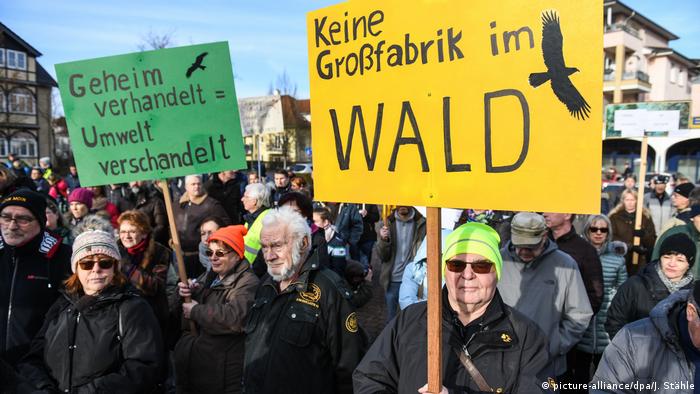
Around 200 demonstrators gathered Saturday in the village of Grünheide, east of Berlin, to protest the clearing of a forest to make way for a Tesla electric car factory.
Residents held posters reading "no factory in the forest" and "Tesla or drinking water" — citing concerns that the factory could contaminate the village's drinking water.
Brandenburg state lawmakers gave Tesla the green light to buy the 300 hectares (741 acres) of land on January 9. Tesla's "Gigafactory 4" will produce up to 500,000 units every year of its Model 3 and Y vehicles and other models, according to the US carmaker.
Tesla said the construction of the factory is scheduled to start in the first half of 2020, with the first cars rolling off assembly lines starting in July 2021. The price tag for the property is €41 million ($45.6 million). Tesla's board still needs to sign off on the deal.
Read more: Opinion: Tesla's Germany plans are no coincidence
Support for Tesla
Local police said more than 30 people took part in a counterdemonstration Saturday in support of the Tesla plant, holding banners reading "construct instead of frustrate" and "Elon, I want a car from you."
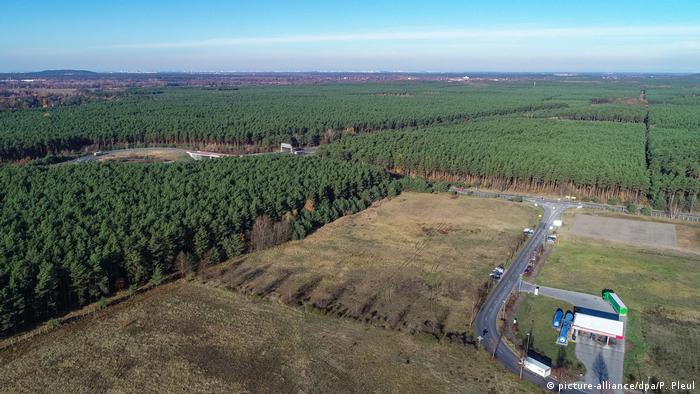
Tesla plans to build the factory on this section of forest in Grünheide, east of Berlin
Germany's DPA news agency reported there were brief verbal altercations when the two sides met.
Tesla's founder, Elon Musk, has said he hopes the company's project in Brandenburg will not run into delays similar to the construction of the Berlin-Brandenburg airport.
Read more: Tesla's China gigafactory delivers first Model 3 in less than a year
Berlin newspaper Der Tagesspiegel recently reported that bomb disposal teams are already searching the forest site for munitions left over from World War II.
Brandenburg, which surrounds Berlin, hopes that the Tesla plant will bring thousands of high-quality jobs to the region. Like other areas of former Communist East Germany, the region's economy lags behind the rest of Germany.
Local residents say a Tesla factory planned for a forested site outside of Berlin will pollute their water and damage the environment. The state of Brandenburg hopes the "Gigafactory 4" will add thousands of jobs.

Around 200 demonstrators gathered Saturday in the village of Grünheide, east of Berlin, to protest the clearing of a forest to make way for a Tesla electric car factory.
Residents held posters reading "no factory in the forest" and "Tesla or drinking water" — citing concerns that the factory could contaminate the village's drinking water.
Brandenburg state lawmakers gave Tesla the green light to buy the 300 hectares (741 acres) of land on January 9. Tesla's "Gigafactory 4" will produce up to 500,000 units every year of its Model 3 and Y vehicles and other models, according to the US carmaker.
Tesla said the construction of the factory is scheduled to start in the first half of 2020, with the first cars rolling off assembly lines starting in July 2021. The price tag for the property is €41 million ($45.6 million). Tesla's board still needs to sign off on the deal.
Read more: Opinion: Tesla's Germany plans are no coincidence
Support for Tesla
Local police said more than 30 people took part in a counterdemonstration Saturday in support of the Tesla plant, holding banners reading "construct instead of frustrate" and "Elon, I want a car from you."

Tesla plans to build the factory on this section of forest in Grünheide, east of Berlin
Germany's DPA news agency reported there were brief verbal altercations when the two sides met.
Tesla's founder, Elon Musk, has said he hopes the company's project in Brandenburg will not run into delays similar to the construction of the Berlin-Brandenburg airport.
Read more: Tesla's China gigafactory delivers first Model 3 in less than a year
Berlin newspaper Der Tagesspiegel recently reported that bomb disposal teams are already searching the forest site for munitions left over from World War II.
Brandenburg, which surrounds Berlin, hopes that the Tesla plant will bring thousands of high-quality jobs to the region. Like other areas of former Communist East Germany, the region's economy lags behind the rest of Germany.
Storm, flooding misery follow bushfires in Australia
Thunderstorms and torrential rain have wreaked havoc in the fire-devastated states of New South Wales, Queensland and Victoria. Despite the wet weather, hundreds of blazes continue to burn and many areas remain dry.

A koala licks rainwater off a road near Moree, New South Wales
Torrential rains and thunderstorms caused further misery for Australians in states already suffering from devastating bushfires.
Several major highways were cut off, while theme parks closed in southeastern Queensland after some of the heaviest rain in months fell in the state. Local media showed video footage of dozens of vehicles being swept away in flash flooding.
Standing water reached 330 millimeters (13 inches) in some areas and Australia's Bureau of Meteorology tweeted that over 100 millimeters of rain was expected to fall across the night and early Saturday morning in many other locations.
The Bureau of Meteorology for Queensland also told drivers to "take care on the roads — if it's flooded, forget it."

Several properties in southern New South Wales were left damaged by floods.
New South Wales and Victoria
New South Wales, where 4.9 million hectares have been destroyed by fire, saw power cuts due to the heavy rainfall.
Firefighters in the southeastern state were hopeful the weather change would bring much-needed respite for areas where dozens of bushfires still raged.
The Rural Fire Service said Saturday it was continuing to make the most of benign conditions to fight "75 bushfires, of which 25 are still to be contained."
The fire service also noted that some parts of the state had yet to receive any moisture, particularly on the far south coast.

Torrential rain hit fire-stricken states in Australia
Less ferocious storms were forecast for Victoria, which has already been hit this week by severe storms and unhealthy smoke from the bushfires.
Across NSW, Victoria, Queensland, South Australia, Western Australia and Tasmania a total of 8.4 million hectares have been destroyed by the fires.
Thunderstorms and torrential rain have wreaked havoc in the fire-devastated states of New South Wales, Queensland and Victoria. Despite the wet weather, hundreds of blazes continue to burn and many areas remain dry.

A koala licks rainwater off a road near Moree, New South Wales
Torrential rains and thunderstorms caused further misery for Australians in states already suffering from devastating bushfires.
Several major highways were cut off, while theme parks closed in southeastern Queensland after some of the heaviest rain in months fell in the state. Local media showed video footage of dozens of vehicles being swept away in flash flooding.
Standing water reached 330 millimeters (13 inches) in some areas and Australia's Bureau of Meteorology tweeted that over 100 millimeters of rain was expected to fall across the night and early Saturday morning in many other locations.
The Bureau of Meteorology for Queensland also told drivers to "take care on the roads — if it's flooded, forget it."

Several properties in southern New South Wales were left damaged by floods.
New South Wales and Victoria
New South Wales, where 4.9 million hectares have been destroyed by fire, saw power cuts due to the heavy rainfall.
Firefighters in the southeastern state were hopeful the weather change would bring much-needed respite for areas where dozens of bushfires still raged.
The Rural Fire Service said Saturday it was continuing to make the most of benign conditions to fight "75 bushfires, of which 25 are still to be contained."
The fire service also noted that some parts of the state had yet to receive any moisture, particularly on the far south coast.

Torrential rain hit fire-stricken states in Australia
Less ferocious storms were forecast for Victoria, which has already been hit this week by severe storms and unhealthy smoke from the bushfires.
Across NSW, Victoria, Queensland, South Australia, Western Australia and Tasmania a total of 8.4 million hectares have been destroyed by the fires.
Virtual reality won't make cows happier, but it might help us see them differently
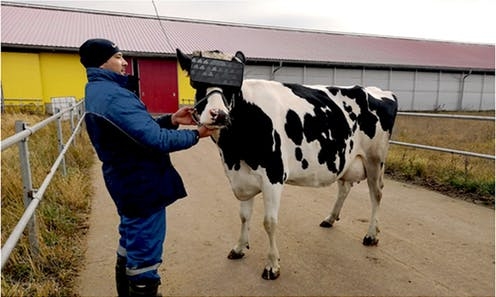
Can virtual reality reality improve a dairy cow's life? Moscow Ministry of Agriculture and Food


Tuesday, December 3, 2019 3:21 AM UTC
Earlier this week, Russian farmers announced they are testing virtual reality (VR) for dairy cows.
Conducted at the RusMoloko farm near Moscow, the trials supposedly use specially adapted goggles to show the animals a view of a pleasant field in summer. The idea is to make the cows happier, which in turn could make them produce more milk.
Some have doubts over whether the tests are real, and it wouldn’t be the first time pictures of animals in VR headsets have been used to capture public attention. Similar images of CatVR and “virtual free range” chickens have appeared in the past.
But to take the idea seriously, at least for a moment: can animals perceive virtual reality the same way we do? And would it do them any good?

The grass may be greener in virtual reality, but you can’t eat it. Moscow Ministry of Agriculture and Food
Virtual entertainment for animals
Unfortunately for the emerging VR industry, there is little to suggest that gazing on a virtual landscape will make cattle happier.
Visual stimulation may be beneficial to some species of animals, but the research relates mostly to primates. Horses in a stable do seem to benefit from a view of other horses and an open window. But the sounds, smells, breeze and associated temperature changes in the real world make for a far richer sensory experience than VR can offer.
Could virtual reality for animals ever be a good idea? Cognition researchers working with chimpanzees have given the animals access to a virtual maze environment to study their spatial cognition abilities.
In this research the chimps were given food rewards when they successfully located objects in the maze. There’s no evidence they enjoyed the VR experience for its own sake. And the chimps didn’t wear VR headsets; the virtual world was displayed on a computer screen and the animals navigated using a joystick.
A visual VR experience might be appealing to humans, but would likely have less inherent value for animals. Humans can understand symbolic imagery, complex language-based events, and the written word. So visual technologies such as television, smartphones and VR can provide us with long-lasting entertainment, intellectual stimulation, and social connection.
This is not so for other species. While some dogs might watch TV, their interest is usually short-lived unless it has a meaningful outcome, such as the opportunity to chase and bark at animals on the screen. Similarly, some cats play with iPads and digital toys for short periods, but usually only keep up the behaviour if they are intermittently given a reward when they catch the “prey”.
Real entertainment for cows
Despite evidence that cattle have the capacity for complex thoughts and feelings, an increasing number of cows are housed year-round in relatively boring and restrictive indoor environments.
At the same time, there is interest in providing cattle with “environmental enrichment”. This takes the form of objects and activities to provide physical and mental stimulation, in the same vein as toys and puzzles for pets and zoo animals. As well as improving the animals’ well-being, it seems to improve dairy production outcomes.
Good animal enrichment addresses the physical and behavioural needs of different species that are not already met in their existing environment. Good enrichment can also give animals more agency – more control over their lives and their environment. For cows, enrichment might look more like a sophisticated brush than a VR headset.
Cows can choose how and when to use the brushing machine.
In our research, we have investigated approaches to designing technology-based enrichment that responds to animals’ real needs. In 2016 we trialled digital enrichment for orangutans at Melbourne Zoo, offering the animals a range of games and apps that could be made more complex as animals learn.
How tech for animals can change humans
There seems to be something inherently fascinating in seeing animals using technology that is “meant for humans”.
When we provided digital games for orangutans at Melbourne Zoo, we investigated the effect on visitors’ perceptions of the primates. We found that seeing the animals using technology influenced people’s empathy for the orangutans. Others have also proposed that digital games for pigs might encourage people to reflect on the needs of farm animals.
So while VR for cows may not directly improve their well-being, it just might encourage people to think more about what animals need.
The five corrupt pillars of climate change denial

By Mark Maslin
Sunday, December 1, 2019
The fossil fuel industry, political lobbyists, media moguls and individuals have spent the past 30 years sowing doubt about the reality of climate change - where none exists. The latest estimate is that the world’s five largest publicly-owned oil and gas companies spend about US$200 million a year on lobbying to control, delay or block binding climate policy.
Their hold on the public seems to be waning. Two recent polls suggested over 75% of Americans think humans are causing climate change. School climate strikes, Extinction Rebellion protests, national governments declaring a climate emergency, improved media coverage of climate change and an increasing number of extreme weather events have all contributed to this shift. There also seems to be a renewed optimism that we can deal with the crisis.
But this means lobbying has changed, now employing more subtle and more vicious approaches – what has been termed as “climate sadism”. It is used to mock young people going on climate protests and to ridicule Greta Thunberg, a 16-year-old young woman with Asperger’s, who is simply telling the scientific truth.
Anti-climate change lobbying spend by the five largest publicly-owned fossil fuel companies. Statista, CC BY-SA
At such a crossroads, it is important to be able to identify the different types of denial. The below taxonomy will help you spot the different ways that are being used to convince you to delay action on climate change.
1. Science denial
This is the type of denial we are all familiar with: that the science of climate change is not settled. Deniers suggest climate change is just part of the natural cycle. Or that climate models are unreliable and too sensitive to carbon dioxide.
Some even suggest that CO₂ is such a small part of the atmosphere it cannot have a large heating affect. Or that climate scientists are fixing the data to show the climate is changing (a global conspiracy that would take thousands of scientists in more than a 100 countries to pull off).
All these arguments are false and there is a clear consensus among scientists about the causes of climate change. The climate models that predict global temperature rises have remained very similar over the last 30 years despite the huge increase in complexity, showing it is a robust outcome of the science.
Model reconstruction of global temperature since 1970. Average of the models in black with model range in grey compared to observational temperature records from NASA, NOAA, HadCRUT, Cowtan and Way, and Berkeley Earth. Carbon Brief, CC BY
The shift in public opinion means that undermining the science will increasingly have little or no effect. So climate change deniers are switching to new tactics. One of Britain’s leading deniers, Nigel Lawson, the former UK chancellor, now agrees that humans are causing climate change, despite having founded the sceptic Global Warming Policy Foundation in 2009.
It says it is “open-minded on the contested science of global warming, [but] is deeply concerned about the costs and other implications of many of the policies currently being advocated”. In other words, climate change is now about the cost not the science.
2. Economic denial
The idea that climate change is too expensive to fix is a more subtle form of climate denial. Economists, however, suggest we could fix climate change now by spending 1% of world GDP. Perhaps even less if the cost savings from improved human health and expansion of the global green economy are taken into account. But if we don’t act now, by 2050 it could cost over 20% of world GDP.
We should also remember that in 2018 the world generated US$86,000,000,000,000 and every year this World GDP grows by 3.5%. So setting aside just 1% to deal with climate change would make little overall difference and would save the world a huge amount of money. What the climate change deniers also forget to tell you is that they are protecting a fossil fuel industry that receives US$5.2 trillion in annual subsidies – which includes subsidised supply costs, tax breaks and environmental costs. This amounts to 6% of world GDP.
The International Monetary Fund estimates that efficient fossil fuel pricing would lower global carbon emissions by 28%, fossil fuel air pollution deaths by 46%, and increase government revenue by 3.8% of the country’s GDP.
3. Humanitarian denial
Climate change deniers also argue that climate change is good for us. They suggest longer, warmer summers in the temperate zone will make farming more productive. These gains, however, are often offset by the drier summers and increased frequency of heatwaves in those same areas. For example, the 2010 “Moscow” heatwave killed 11,000 people, devastated the Russian wheat harvest and increased global food prices.
Geographical zones of the world. The tropical zones span from the Tropic of Cancer in the North to the Tropic of Capricorn in the South (red shaded region) and contains 40% of the World population. Maulucioni/Wikipedia, CC BY-SA
More than 40% of the world’s population also lives in the Tropics – where from both a human health prospective and an increase in desertification no one wants summer temperatures to rise.
Deniers also point out that plants need atmospheric carbon dioxide to grow so having more of it acts like a fertiliser. This is indeed true and the land biosphere has been absorbing about a quarter of our carbon dioxide pollution every year. Another quarter of our emissions is absorbed by the oceans. But losing massive areas of natural vegetation through deforestation and changes in land use completely nullifies this minor fertilisation effect.
Climate change deniers will tell you that more people die of the cold than heat, so warmer winters will be a good thing. This is deeply misleading. Vulnerable people die of the cold because of poor housing and not being able to afford to heat their homes. Society, not climate, kills them.
This argument is also factually incorrect. In the US, for example, heat-related deaths are four times higher than cold-related ones. This may even be an underestimate as many heat-related deaths are recorded by cause of death such as heart failure, stroke, or respiratory failure, all of which are exacerbated by excessive heat.
US weather fatalities for 2018 alongside the ten- and 30-year average. National Weather Service, CC BY
4. Political denial
Climate change deniers argue we cannot take action because other countries are not taking action. But not all countries are equally guilty of causing current climate change. For example, 25% of the human-produced CO₂ in the atmosphere is generated by the US, another 22% is produced by the EU. Africa produces just under 5%.
Given the historic legacy of greenhouse gas pollution, developed countries have an ethical responsibility to lead the way in cutting emissions. But ultimately, all countries need to act because if we want to minimise the effects of climate change then the world must go carbon zero by 2050.
Per capita annual carbon dioxide emissions and cumulative country emissions. Data from the Global Carbon Project. Nature. Data from the Global Carbon Project
Per capita annual carbon dioxide emissions and cumulative country emissions. Data from the Global Carbon Project. Nature (data from the Global Carbon Project)
Deniers will also tell you that there are problems to fix closer to home without bothering with global issues. But many of the solutions to climate change are win-win and will improve the lives of normal people. Switching to renewable energy and electric vehicles, for example, reduces air pollution, which improves people’s overall health.
Developing a green economy provides economic benefits and creates jobs. Improving the environment and reforestation provides protection from extreme weather events and can in turn improve food and water security.
5. Crisis denial
The final piece of climate change denial is the argument that we should not rush into changing things, especially given the uncertainty raised by the other four areas of denial above. Deniers argue that climate change is not as bad as scientists make out. We will be much richer in the future and better able to fix climate change. They also play on our emotions as many of us don’t like change and can feel we are living in the best of times – especially if we are richer or in power.
But similarly hollow arguments were used in the past to delay ending slavery, granting the vote to women, ending colonial rule, ending segregation, decriminalising homosexuality, bolstering worker’s rights and environmental regulations, allowing same sex marriages and banning smoking.
The fundamental question is why are we allowing the people with the most privilege and power to convince us to delay saving our planet from climate change?
Subscribe to:
Comments (Atom)

